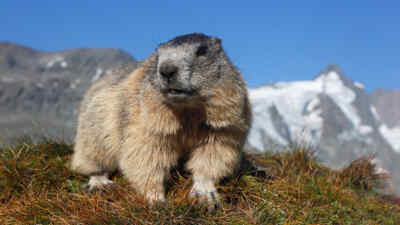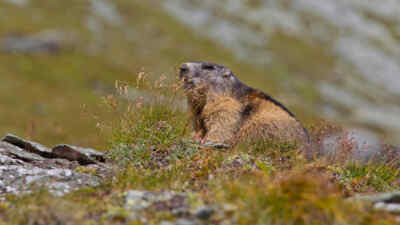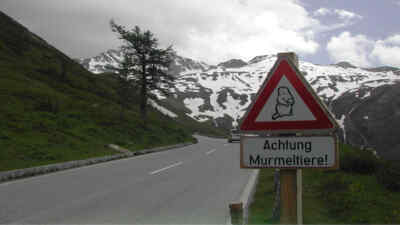
The marmot
The marmot: alpine resident with a kick
Cute alpine marmots and perpetual late risers
If you didn’t discover them during your drive on the Grossglockner High Alpine Road, you will see them on the Kaiser-Franz-Josefs-Höhe: the alpine marmots. These furry high mountain residents have very sociable and are therefore most curious. They have become accustomed to human visitors on the Kaiser-Franz-Josefs-Höhe and having most lost their natural shyness. Less trusting marmots can be observed with binoculars from the Swarovski-Beobachtungswarte and the Murmi-Schau of the Haus Alpine natural exhibition is an absolute highlight.
Far travellers: the ramified marmot family
Marmots have been proven to have existed ever since the Ice Age 2.5 million years ago. They migrated across the continents and are therefore still widespread in Eurasia and North America. The rodents, members of the squirrel group, have adapted to their respective surroundings. Fourteen marmot species are currently known, of which one is the alpine marmot living on the Grossglockner. The brisk rodents can grow up to 30 to 60 cm in length in addition to a 10 to 25 cm tail. Their natural lifespan is up to 15 years. One striking feature are their long, yellowish and very powerful buckteeth. Strong back teeth help to grind grass and herbs. Fruit, seeds and insects are occasionally part of their diet as well.
Territory with a splendid view: marmot habitat above the timber line
After the end of the Ice Age, the marmots retreated to treeless high mountain regions. A reason for this might be that the “Mankei” cannot stand the heat. It only has few sweat glands, even spending warm sunny hours on the mountain in its cool lair. The alpine marmot is perfectly equipped for its underground construction projects with its compact body, short legs and round ears. It digs extensive vein tracts with individual tunnels that are up to 10-70 m long. Caves with living and sleeping quarters, special toilets and escape tunnels are also part of the elaborate marmot lair. After all, that’s where the entire family goes into a long period of hibernation in winter.
Sleep until the sun comes out – hibernation of the marmots
When the days become shorter, the energy content of the food declines and sufficient fat reserves have been amassed, the marmot and its family retreats to the underground coves to start hibernating. Even though snow continuously falls on the meadows and pastures, it’s still warm and comfy down there. During its six to nine months of hibernation, the marmot lowers all vital functions to only use as little energy as necessary. The entrance to the lair is sealed tightly. Every three to four weeks, the “Mankei” takes a toilet break before returning to its deep sleep. By the end of hibernation, each marmot has lost a third of its weight – time to be awoken by its biological clock!
Starting over in spring: the colony of alpine marmots
How lovely it is when everyone welcomes one another after a long winter by rubbing noses, putting their heads together and enjoying the spring sun! Mating season starts as early as April/May and the multi-generational families forage for food. The shrill screams of the marmots coming from the larynx, which we interpret as whistling, have communicational and warning purposes. Hatchlings, which are given birth to after a 30-day gestation period, are particularly imperilled: when a bird of prey appears on the sky above the Grossglockner, the marmots hurry to seek shelter for themselves and their little ones.
You’d like to observe these furry alpine residents in the wild yourself? Then find out more about the opening hours and road charges of the Grossglockner High Alpine Road now!

